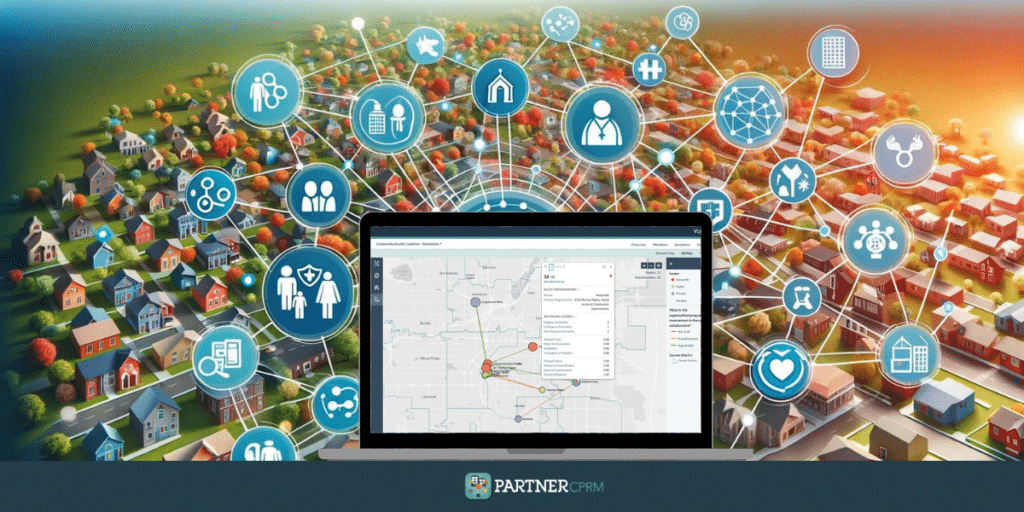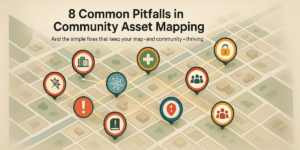In today’s interconnected world, organizations and communities often discover that traditional hierarchical approaches fall short when tackling complex challenges. As issues become more intricate and stakeholders more diverse, there’s an increasing need for strategies that emphasize collaboration, interdependence, and shared resources. This is where network strategies offer a significant advantage.
By leveraging the power of social and organizational networks, leaders can create more resilient, adaptive, and effective solutions to achieve their goals.
Table of Contents
When Does a Network Strategy Make Sense?
Not every situation or problem requires a network. To help organizations identify when to apply a networked approach, we’ll explore different types of goals and objectives where collaborative strategies are a strong fit. These examples will illustrate how organizations can use social network analysis (SNA) and collaborative network strategies to make measurable impacts in their communities.
1. Complex Problem-Solving
When addressing multifaceted challenges—such as social determinants of health, environmental sustainability, or economic development—no single organization has all the answers. These “wicked problems” require diverse perspectives, skills, and resources to find solutions.
A network strategy enables organizations to:
- Collaborate across sectors: Bringing together stakeholders from government, nonprofit, academic, and private sectors leads to richer solutions by leveraging diverse expertise.
- Share resources and knowledge: Networked groups can pool resources and knowledge to increase problem-solving capacity. Mapping relationships and assessing trust levels help leaders identify opportunities for effective partnerships.
Example: A public health coalition aiming to reduce chronic diseases could include healthcare providers, community organizations, businesses, and policymakers. By using a network approach, stakeholders can coordinate efforts, share data, and drive systemic change more effectively than by working in isolation.
💡Practical Tip:
Start by conducting a network analysis to map out the key players and identify any missing voices or bottlenecks that could hinder collaboration.

2. Innovation and Knowledge Exchange
For organizations fostering innovation or speeding up knowledge sharing, network strategies provide a significant boost. Innovation thrives in environments where ideas flow freely and connections span across boundaries.
A network strategy promotes:
- Cross-pollination of ideas: Networks that connect people with diverse expertise foster creativity and breakthroughs.
- Peer learning: Networks create platforms for members to share best practices, lessons learned, and emerging trends, fostering continuous learning.
Example: A global network of social entrepreneurs working on climate change can use their connections to exchange cutting-edge ideas, crowdsource solutions, and rapidly replicate successful models.
💡Practical Tip:
Encourage peer learning by hosting regular cross-sectoral meetings where members can share knowledge and discuss challenges and successes.

3. Building Resilience
In a rapidly changing world, organizations and communities need to build resilience. A networked approach strengthens resilience by leveraging interconnectedness and trust among members, allowing quicker recovery and adaptation to challenges.
A network strategy helps to:
- Diversify resources and support: A resilient network allows members to access a broader range of financial, technical, or emotional support.
- Create rapid response capabilities: High connectivity and trust enable faster communication and mobilization during crises.
Example: A regional emergency preparedness network including local governments, NGOs, and businesses can efficiently mobilize resources and respond collectively when disasters strike due to their strong ties and trust.
💡Practical Tip:
Periodically assess the connectivity and trust levels within your network to ensure that resources and relationships are distributed in ways that enhance resilience.

4. Advocacy and Collective Action
Advocacy efforts requiring broad-based support benefit from strong network infrastructures. When multiple actors need to align their voices to influence policy or drive social change, networks provide the needed cohesion and reach.
A network strategy is critical for:
- Amplifying voices: By uniting stakeholders across sectors and geographies, networks expand the reach and power of advocacy campaigns.
- Building trust and cohesion: Networks deepen relationships, foster trust, and build long-term collaboration.
Example: A global human rights movement might connect local grassroots organizations with international advocacy groups, aligning efforts to create a unified and powerful voice for policy change.
💡Practical Tip:
Use network data to identify the most influential and well-connected partners with key decision-makers to ensure maximum advocacy impact.

5. Strategic Resource Allocation
When optimizing resource allocation or identifying strategic partnerships, networks offer a clear advantage. Understanding network structures can reveal untapped resources, collaboration opportunities, and inefficiencies.
A network strategy can:
- Identify key connectors: Organizations with high centrality serve as crucial bridges in a network and are often ideal partners for joint initiatives.
- Reveal gaps or bottlenecks: By mapping relationships and analyzing metrics like density, leaders can target areas where collaboration is weak or underutilized.
Example: A network of community service organizations might map its relationships to find agencies playing central roles and determine where additional resources could improve overall impact.
💡Practical Tip:
Consider the diverse ways different members of your network create shared value (not just funding). For example: volunteers and staff, expertise, data, power and influence, involvement, leadership, and feedback.

6. Measuring Impact and Accountability
Networks also serve as valuable tools for tracking progress and improving accountability. Mapping relationships and measuring changes in connectivity can show how interventions are influencing the network.
A network strategy supports:
- Monitoring collaboration effectiveness: Metrics such as network density and centralization reveal whether a network is becoming more cohesive or fragmented over time.
- Evaluating equity and inclusion: Network analysis can highlight whether all voices are being represented or if a few actors are disproportionately benefiting.
Example: A nonprofit focused on education might use network analysis to assess if its partnerships with schools and community groups are strengthening over time and contributing to improved student outcomes.
💡Practical Tip:
Use PARTNER CPRM to track changes in network connectivity and analyze trust and value scores to ensure your interventions are yielding the desired outcomes.

7. Systems Change Initiatives
For organizations seeking to address systemic issues or drive broad societal changes, a network strategy rooted in systems thinking is essential. Systems thinking emphasizes understanding how interconnected components within a larger system influence one another, helping to identify leverage points for sustainable change.
A network strategy for systems change helps organizations to:
- Identify leverage points: By mapping the relationships and power dynamics within a system, network strategies help pinpoint where interventions can have the greatest impact.
- Foster collaboration across the system: Systems change often requires collective efforts from a wide range of stakeholders, including policymakers, funders, service providers, and the communities affected.
Example: A coalition working to reform the criminal justice system might use a network strategy to connect organizations across the legal, social services, and community advocacy sectors. By identifying key leverage points within the system—such as policy changes or community-based interventions—the coalition can work collaboratively to drive sustainable reform.
💡Practical Tip:
Use systems thinking to map out not just direct relationships, but also the broader influences and feedback loops within your network. This will help identify where small changes can lead to significant shifts.

Get the Most from Your Network with PARTNER CPRM
Harnessing the power of networks requires the right tools. The PARTNER CPRM platform makes it easy to map, track, and analyze your network’s relationships, helping you optimize collaboration, identify key players, and ensure resources are efficiently leveraged. Whether you’re looking to foster innovation, build resilience, or drive collective action, PARTNER CPRM offers the insights and strategies you need to make informed, data-driven decisions.
Start maximizing the potential of your network today by contacting us for a demo.
Conclusion: When Is a Network Strategy the Right Fit?
Network strategies are ideal for tackling complexity, fostering innovation, building resilience, and amplifying collective voices. By leveraging SNA tools to understand trust levels, connectivity, and relationships, organizations can build stronger networks and enhance their overall impact. As we face increasingly interconnected challenges, the ability to strategically use networks will be critical for success in every sector.
FAQs
Q: What is the primary benefit of using a network strategy for problem-solving?
A: A network strategy allows organizations to tap into the collective resources, knowledge, and skills of diverse stakeholders. This is especially useful for complex, multifaceted problems where no single organization has all the expertise or capacity to find a solution. By working collaboratively, organizations can develop more comprehensive, adaptive solutions that are better equipped to handle the intricacies of modern challenges.
Q: How can I identify the right partners in my network for a specific project or initiative?
A: Using Social Network Analysis (SNA) tools, like those in the PARTNER CPRM platform, can help you map your network and analyze key metrics such as centrality (which organizations connect others), trust, and value. These insights allow you to identify partners who are not only well-connected but also contribute the most resources or have the greatest influence within the network. This data-driven approach ensures that you’re forming partnerships with organizations that can best support your goals.
Q: What is social network analysis (SNA), and how does it improve collaboration?
A: Social Network Analysis (SNA) is a method for studying the relationships between organizations or individuals in a network. By visualizing connections and measuring factors like trust, value, and resource sharing, SNA helps identify strengths, gaps, and opportunities within a network. This insight improves collaboration by highlighting the most strategic areas for partnership, revealing potential bottlenecks, and ensuring resources are shared efficiently. Read more here.
Q: How can I measure the impact of my network’s collaboration efforts over time?
A: PARTNER CPRM enables you to track key network metrics, such as changes in connectivity, trust, and resource exchange, over time. By regularly conducting network surveys and updating your network map, you can see how relationships evolve and assess whether your interventions are strengthening collaboration. Additionally, metrics like density (the level of interconnectedness) and centralization (whether certain members dominate the network) help monitor the effectiveness and inclusivity of your efforts.
Q: My network is large—how do I prevent member burnout while maintaining high levels of collaboration?
A: It’s crucial to balance the intensity of relationships within your network. Not every connection needs to be highly integrated; sometimes, cooperative or coordinated relationships are enough. Assessing the levels of collaboration across your network using tools like the PARTNER CPRM can help identify which relationships require deeper engagement and which can remain lighter, reducing the burden on members. Setting up subgroups within your network to handle specific tasks can also distribute workloads more evenly and prevent burnout.
Q: What’s the difference between network density and centralization, and why do they matter?
A: Network density refers to the percentage of possible connections that actually exist in a network. A high-density network means most members are connected, leading to easier communication and collaboration. However, too much density can create redundancy and overload members with too many connections. Centralization measures how much the network is dominated by one or a few central members. Highly centralized networks can be efficient but are vulnerable if those central members leave. Both metrics help you balance connectivity and resilience in your network.
Q: How can I ensure my network remains equitable and inclusive?
A: Regularly analyzing the demographic, sectoral, and geographic diversity within your network is key to ensuring equitable representation. Tools like PARTNER CPRM allow you to track who holds the most power, influence, and resources in your network. This helps you ensure that no single group dominates and that underrepresented voices are heard. By actively monitoring these dynamics, you can take steps to include more diverse perspectives and foster an inclusive environment.
Q: Can network strategies work for smaller organizations or grassroots movements?
A: Absolutely. In fact, network strategies are particularly valuable for smaller organizations and grassroots movements because they allow for the pooling of limited resources and amplifying impact. Smaller entities can leverage the trust and connections within their networks to gain visibility, access larger audiences, and collaborate on solutions that would be difficult to achieve alone. By mapping their relationships, even small networks can identify valuable partners and optimize collaboration.






